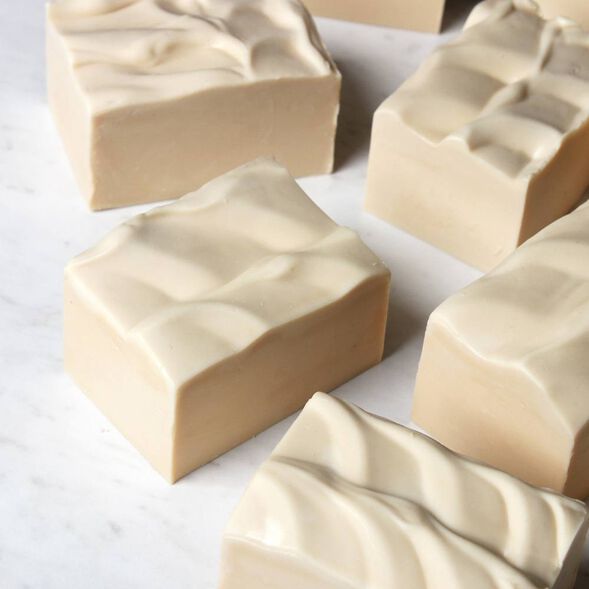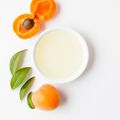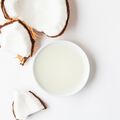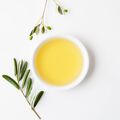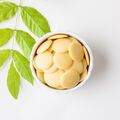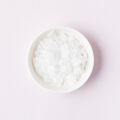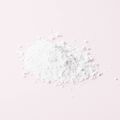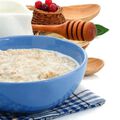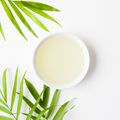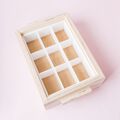
Creamy Goat Milk Soap Project
- Skill Level: Intermediate
- Time: 2 hours
- Yield: 3 pounds of soap
Project Description
Goat milk is particularly nourishing because of capric/caprylic triglyceride, which forms a barrier on the skin to help inhibit the loss of moisture. It also contains vitamins A, D, and B6, and lactic acid.
This recipe contains goat milk from a local farm. You may be able to find it at your local grocery store, co-op, or farmers market. If you can’t get your hands on the fresh stuff, powdered goat milk is a great alternative.
Creating goat milk soap does take some extra prep work. It needs to be kept cold to prevent scorching. Learn how to prep milk for soap here.
If you’re ready to dive in, this recipe is perfect. It’s simple with one color and a thick texture, so no need to worry stick blending too much. It’s scented with Oatmeal Milk and Honey Fragrance Oil, which is one of our most popular fragrance oils. It does discolor in cold process soap, so titanium dioxide is added to keep the bars light and creamy looking.
You will need:
- 9 Bar Birchwood Mold
- Silicone Liner for 9 Bar Mold
- 5.3 oz. Apricot Kernel Oil (15%)
- 8.8 oz. Coconut Oil (25%)
- 11.5 oz. Olive Oil Pomace (33%)
- 2.5 oz. Cocoa Butter (7%)
- 7 oz. Palm Oil (20%)
- 4.9 oz. Sodium Hydroxide Lye
- 11.6 oz. Goat Milk
- 2 oz. Oatmeal Milk and Honey Fragrance Oil
- Titanium Dioxide
MILK PREP: When lye is added to milk, it heats up to around 200° F. That causes discoloration and an unpleasant odor. To prevent scorching, our preferred technique is to freeze the goat milk before adding lye.
Measure out 11.6 ounces of goat milk and pour it into ice cube trays (we used Medium 9 Ball Silicone Molds). Freeze overnight. Then, place a heat-safe container on a scale and weigh out the frozen cubes. Some might be lost in the freezing/transferring process. If you're missing any, pour cold goat milk or distilled water into the container until you have 11.6 ounces.
SAFETY FIRST: Suit up for safe handling practices. That means goggles, gloves, and long sleeves. Make sure kids, pets, other distractions, and tripping hazards are out of the house or don’t have access to your space. Always make soap in a well-ventilated area.
LYE PREP: With safety gear on, slowly add about ¼ of the lye flakes to the frozen goat milk. Use a stainless steel spoon to stir. Slowly, the flakes will begin to melt the goat milk cubes. After a few minutes of stirring, add another ¼ of the flakes and stir for several minutes. Continue this process until all the lye flakes have been added. Once the milk has fully melted, keep stirring to make sure all the lye flakes have completely dissolved. Because the temperatures are low, the lye flakes do not dissolve as quickly. Patience is key!
Below, our milk reached about 90° F and developed a very slight yellow color. That's fine for this recipe. If you want a lighter shade, place the container in an ice bath to keep it extra cold. Optional: Add 2 teaspoons of sodium lactate to help the bars harden more quickly.
COLORANT PREP: Disperse 3 teaspoons of titanium dioxide into 2 tablespoons of lightweight liquid oil, like sweet almond oil or sunflower oil. Optional: To ensure the titanium dioxide blends smoothly into the soap, we recommend micronizing it before dispersing it in oil. Use a coffee grinder to break up any clumps of color and prevent streaks of white from showing in the final soap. We like to use a coffee grinder that has a removable stainless steel mixing area for easy cleaning.
FRAGRANCE PREP: Measure 2 ounces of Oatmeal Milk and Honey Fragrance Oil into a glass container. Set aside.
Follow these steps:
1
Fully melt and combine 8.8 ounces of coconut oil, 7 ounces of palm oil, 11.5 ounces of olive oil pomace, 2.5 ounces of cocoa butter, and 5.3 ounces of apricot kernel oil. Once the oils have cooled to 130° F or below, add the Oatmeal Milk and Honey Fragrance Oil directly to the oils. Usually fragrance oils are added at trace, but because we know this one behaves so well, it can be added first.
2
Add the milk and lye solution slowly to the oils and begin pulsing your stick blender. Because you're adding cold milk to oils that solidify at room temperature, pouring and stirring slowly keeps them melted.
3
Continue to blend until thin to medium trace.
4
Add all the dispersed titanium dioxide and stick blend to incorporate.
5
Pour the soap into the mold. Tap it firmly on the counter to eliminate air bubbles, and use a spoon or spatula to spread the soap evenly into the mold.
6
Using a small stainless steel spoon, create texture on the top of the soap. There is no right or wrong way to do this, so have fun with it!
7
Insert the dividers into the mold. Push them all the way to the bottom. Spray the top with 99% isopropyl alcohol to help prevent soda ash. Place the soap in the freezer for 24 hours. Then, remove to room temperature and let it sit 3-4 days. If you find the silicone liner is not pulling away from the sides of the mold easily, give it another day to harden. Remove the soap from the dividers and allow the bars to cure for 4-6 weeks. Enjoy!
Tutorial credits
Photographer: Amanda Kerzman

Creamy Goat Milk Soap Project
- Skill Level: Intermediate
- Time: 2 hours
- Yield: 3 pounds of soap
Project Description
Goat milk is particularly nourishing because of capric/caprylic triglyceride, which forms a barrier on the skin to help inhibit the loss of moisture. It also contains vitamins A, D, and B6, and lactic acid.
This recipe contains goat milk from a local farm. You may be able to find it at your local grocery store, co-op, or farmers market. If you can’t get your hands on the fresh stuff, powdered goat milk is a great alternative.
Creating goat milk soap does take some extra prep work. It needs to be kept cold to prevent scorching. Learn how to prep milk for soap here.
If you’re ready to dive in, this recipe is perfect. It’s simple with one color and a thick texture, so no need to worry stick blending too much. It’s scented with Oatmeal Milk and Honey Fragrance Oil, which is one of our most popular fragrance oils. It does discolor in cold process soap, so titanium dioxide is added to keep the bars light and creamy looking.
You will need:
- 9 Bar Birchwood Mold
- Silicone Liner for 9 Bar Mold
- 5.3 oz. Apricot Kernel Oil (15%)
- 8.8 oz. Coconut Oil (25%)
- 11.5 oz. Olive Oil Pomace (33%)
- 2.5 oz. Cocoa Butter (7%)
- 7 oz. Palm Oil (20%)
- 4.9 oz. Sodium Hydroxide Lye
- 11.6 oz. Goat Milk
- 2 oz. Oatmeal Milk and Honey Fragrance Oil
- Titanium Dioxide
MILK PREP: When lye is added to milk, it heats up to around 200° F. That causes discoloration and an unpleasant odor. To prevent scorching, our preferred technique is to freeze the goat milk before adding lye.
Measure out 11.6 ounces of goat milk and pour it into ice cube trays (we used Medium 9 Ball Silicone Molds). Freeze overnight. Then, place a heat-safe container on a scale and weigh out the frozen cubes. Some might be lost in the freezing/transferring process. If you're missing any, pour cold goat milk or distilled water into the container until you have 11.6 ounces.
SAFETY FIRST: Suit up for safe handling practices. That means goggles, gloves, and long sleeves. Make sure kids, pets, other distractions, and tripping hazards are out of the house or don’t have access to your space. Always make soap in a well-ventilated area.
LYE PREP: With safety gear on, slowly add about ¼ of the lye flakes to the frozen goat milk. Use a stainless steel spoon to stir. Slowly, the flakes will begin to melt the goat milk cubes. After a few minutes of stirring, add another ¼ of the flakes and stir for several minutes. Continue this process until all the lye flakes have been added. Once the milk has fully melted, keep stirring to make sure all the lye flakes have completely dissolved. Because the temperatures are low, the lye flakes do not dissolve as quickly. Patience is key!
Below, our milk reached about 90° F and developed a very slight yellow color. That's fine for this recipe. If you want a lighter shade, place the container in an ice bath to keep it extra cold. Optional: Add 2 teaspoons of sodium lactate to help the bars harden more quickly.
COLORANT PREP: Disperse 3 teaspoons of titanium dioxide into 2 tablespoons of lightweight liquid oil, like sweet almond oil or sunflower oil. Optional: To ensure the titanium dioxide blends smoothly into the soap, we recommend micronizing it before dispersing it in oil. Use a coffee grinder to break up any clumps of color and prevent streaks of white from showing in the final soap. We like to use a coffee grinder that has a removable stainless steel mixing area for easy cleaning.
FRAGRANCE PREP: Measure 2 ounces of Oatmeal Milk and Honey Fragrance Oil into a glass container. Set aside.
Follow these steps:
1
Fully melt and combine 8.8 ounces of coconut oil, 7 ounces of palm oil, 11.5 ounces of olive oil pomace, 2.5 ounces of cocoa butter, and 5.3 ounces of apricot kernel oil. Once the oils have cooled to 130° F or below, add the Oatmeal Milk and Honey Fragrance Oil directly to the oils. Usually fragrance oils are added at trace, but because we know this one behaves so well, it can be added first.
2
Add the milk and lye solution slowly to the oils and begin pulsing your stick blender. Because you're adding cold milk to oils that solidify at room temperature, pouring and stirring slowly keeps them melted.
3
Continue to blend until thin to medium trace.
4
Add all the dispersed titanium dioxide and stick blend to incorporate.
5
Pour the soap into the mold. Tap it firmly on the counter to eliminate air bubbles, and use a spoon or spatula to spread the soap evenly into the mold.
6
Using a small stainless steel spoon, create texture on the top of the soap. There is no right or wrong way to do this, so have fun with it!
7
Insert the dividers into the mold. Push them all the way to the bottom. Spray the top with 99% isopropyl alcohol to help prevent soda ash. Place the soap in the freezer for 24 hours. Then, remove to room temperature and let it sit 3-4 days. If you find the silicone liner is not pulling away from the sides of the mold easily, give it another day to harden. Remove the soap from the dividers and allow the bars to cure for 4-6 weeks. Enjoy!
Tutorial credits
Photographer: Amanda Kerzman
You will need:
- 9 Bar Birchwood Mold
- Silicone Liner for 9 Bar Mold
- 5.3 oz. Apricot Kernel Oil (15%)
- 8.8 oz. Coconut Oil (25%)
- 11.5 oz. Olive Oil Pomace (33%)
- 2.5 oz. Cocoa Butter (7%)
- 7 oz. Palm Oil (20%)
- 4.9 oz. Sodium Hydroxide Lye
- 11.6 oz. Goat Milk
- 2 oz. Oatmeal Milk and Honey Fragrance Oil
- Titanium Dioxide
MILK PREP: When lye is added to milk, it heats up to around 200° F. That causes discoloration and an unpleasant odor. To prevent scorching, our preferred technique is to freeze the goat milk before adding lye.
Measure out 11.6 ounces of goat milk and pour it into ice cube trays (we used Medium 9 Ball Silicone Molds). Freeze overnight. Then, place a heat-safe container on a scale and weigh out the frozen cubes. Some might be lost in the freezing/transferring process. If you're missing any, pour cold goat milk or distilled water into the container until you have 11.6 ounces.
SAFETY FIRST: Suit up for safe handling practices. That means goggles, gloves, and long sleeves. Make sure kids, pets, other distractions, and tripping hazards are out of the house or don’t have access to your space. Always make soap in a well-ventilated area.
LYE PREP: With safety gear on, slowly add about ¼ of the lye flakes to the frozen goat milk. Use a stainless steel spoon to stir. Slowly, the flakes will begin to melt the goat milk cubes. After a few minutes of stirring, add another ¼ of the flakes and stir for several minutes. Continue this process until all the lye flakes have been added. Once the milk has fully melted, keep stirring to make sure all the lye flakes have completely dissolved. Because the temperatures are low, the lye flakes do not dissolve as quickly. Patience is key!
Below, our milk reached about 90° F and developed a very slight yellow color. That's fine for this recipe. If you want a lighter shade, place the container in an ice bath to keep it extra cold. Optional: Add 2 teaspoons of sodium lactate to help the bars harden more quickly.
COLORANT PREP: Disperse 3 teaspoons of titanium dioxide into 2 tablespoons of lightweight liquid oil, like sweet almond oil or sunflower oil. Optional: To ensure the titanium dioxide blends smoothly into the soap, we recommend micronizing it before dispersing it in oil. Use a coffee grinder to break up any clumps of color and prevent streaks of white from showing in the final soap. We like to use a coffee grinder that has a removable stainless steel mixing area for easy cleaning.
FRAGRANCE PREP: Measure 2 ounces of Oatmeal Milk and Honey Fragrance Oil into a glass container. Set aside.
Follow these steps:
1
Fully melt and combine 8.8 ounces of coconut oil, 7 ounces of palm oil, 11.5 ounces of olive oil pomace, 2.5 ounces of cocoa butter, and 5.3 ounces of apricot kernel oil. Once the oils have cooled to 130° F or below, add the Oatmeal Milk and Honey Fragrance Oil directly to the oils. Usually fragrance oils are added at trace, but because we know this one behaves so well, it can be added first.
2
Add the milk and lye solution slowly to the oils and begin pulsing your stick blender. Because you're adding cold milk to oils that solidify at room temperature, pouring and stirring slowly keeps them melted.
3
Continue to blend until thin to medium trace.
4
Add all the dispersed titanium dioxide and stick blend to incorporate.
5
Pour the soap into the mold. Tap it firmly on the counter to eliminate air bubbles, and use a spoon or spatula to spread the soap evenly into the mold.
6
Using a small stainless steel spoon, create texture on the top of the soap. There is no right or wrong way to do this, so have fun with it!
7
Insert the dividers into the mold. Push them all the way to the bottom. Spray the top with 99% isopropyl alcohol to help prevent soda ash. Place the soap in the freezer for 24 hours. Then, remove to room temperature and let it sit 3-4 days. If you find the silicone liner is not pulling away from the sides of the mold easily, give it another day to harden. Remove the soap from the dividers and allow the bars to cure for 4-6 weeks. Enjoy!
Tutorial credits
Photographer: Amanda Kerzman

